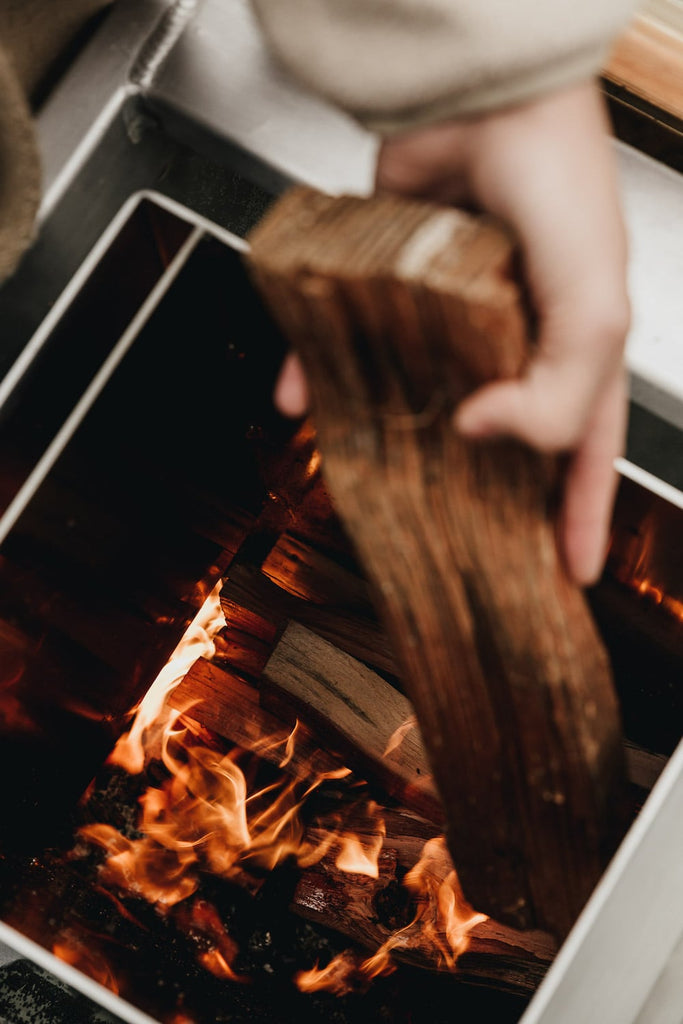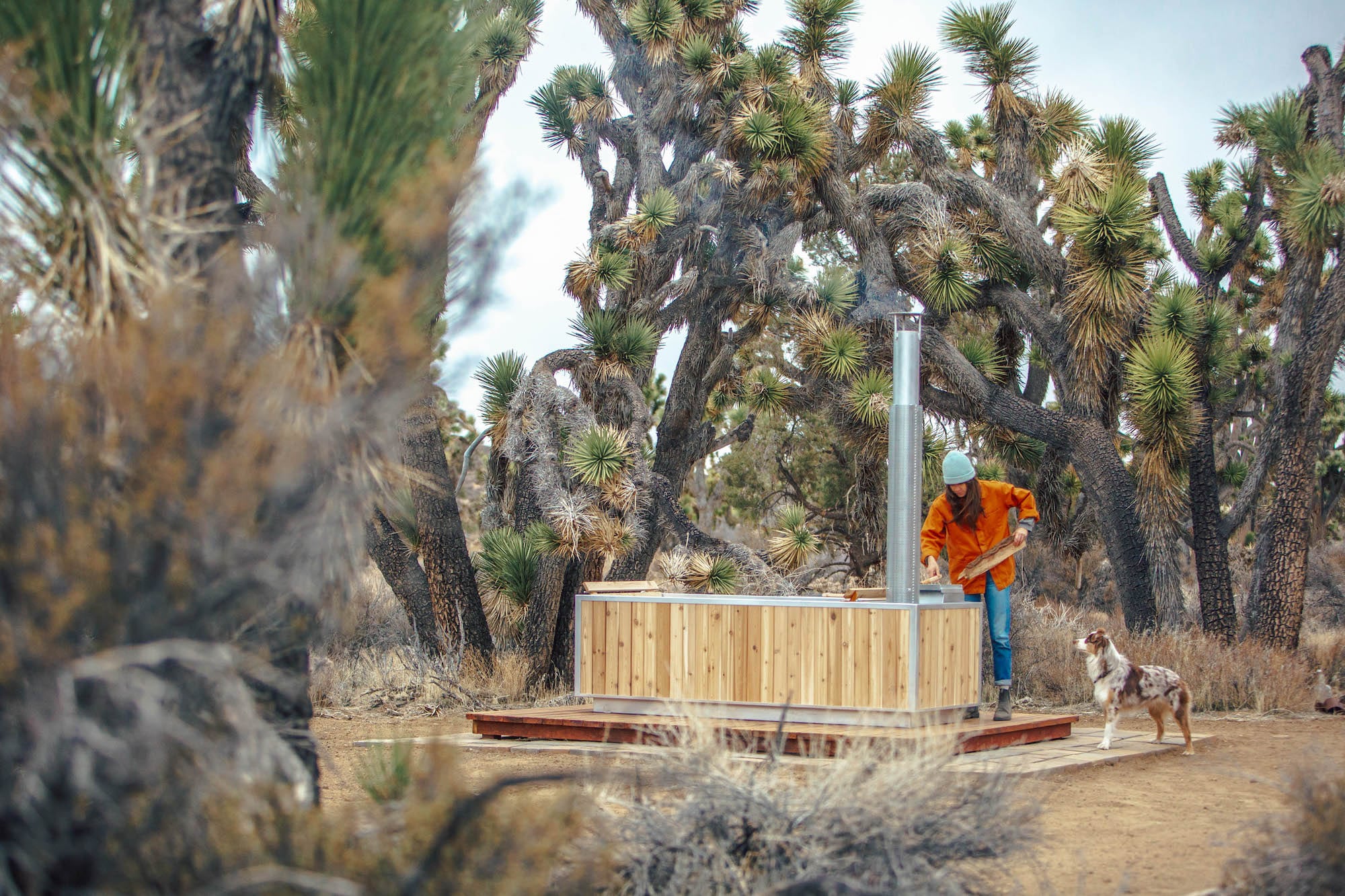To some, wood stove hot tubs are romantic, rustic, and authentic. To others, they’re mysterious and somewhat complex. This latter view is understandable. Making a small fire to heat a large tub of water seems like a hassle when our brains have been hardwired to plug devices in.
However, they’re far from complicated. Fire heated hot tubs bring us back to the basics—back to when humans lit a fire for heat, cooking, and bathing. Using fire slows the process, forcing you to be actively present in the experience as you prepare for the end result, whether it be a delicious home cooked meal or a quiet steamy soak.

Despite not having a plug, hot tubs with wood stoves are very simple to operate. Just like a conventional wood stove in a cabin, all they require is a small amount of manual labour in the form of making a fire and feeding it with wood.

Better yet, minimal effort is required after bathing. Unlike electric hot tubs, fired heated hot tubs don’t require chemicals or a minor in Chemistry to figure out safe pH levels. Salt or fresh water may be used. Overall maintenance is far simpler, especially for marine grade aluminum-lined hot tubs.

How A Wood Burning Stove Works
A respectable fire requires heat, a fuel source, and oxygen. Stack the kindling loosely and the fire takes advantage of the available air and burns properly. The alternative (not enough air) snuffs out flames, causing the wood to smolder instead of burn.
Wood burning stoves work by containing the energy produced by the fire in the stove in which wood can burn efficiently and produce heat. The efficiency comes from controlling both the amount of wood and the supply of air to the fire. Other points:
- Airflow to the fire is controlled by opening and closing the lid to the stove (also known as ‘dampening’)
- When the airflow is limited, less air ‘feeds’ the fire, helping it burn more slowly and efficiently
- The stove’s size and volume of water affect how quickly the fire is able to heat the water
- A heat exchanger (two pipes that pass water over the fire) helps heat up and circulate water throughout the tub
- The aluminum stove conducts heat generated by the fire into the surrounding water
Now let’s take a look at how wood stoves work in wood burning hot tubs.

Types of Wood Stove Hot Tubs
There are two different types of wood stoves for hot tubs. Each one has its advantages and disadvantages.

Internal heater
The hot tub heater is submersed in the tub. Made from durable marine-grade aluminum, the firebox is watertight and won’t corrode. The stove lid or door allows you to control air intake to the fire. By controlling the air, you can affect the temperature of the fire and therefore how quickly it heats the water.
- Heats the water more quickly than an external stove because of its complete water contact and more efficient transfer of heat into the water
- Better for controlling heat
- Allows you to add wood without getting into the chilly air to feed the fire
- Stove gets warm but is safely separated from bathers by a barricade or ‘fence’
- Requires a chimney
The GOODLAND Wood Burning Hot Tub (shown in most images) has an internal heater.

External heater
This type of wood stove heater is located outside the tub (‘external’) and connects to it with pipes. An external heater is slightly more technical: it relies on the physics of thermosiphon, a pumping action created by rising hot water. Cold water is drawn into the heater to be heated, and then circulates out as hot water.
- Takes longer to heat up – approx. three hours, depending on hot tub size
- Uses more wood and is less efficient – much of the heat and energy generated by the fire isn’t transferred to the water but lost to the atmosphere
- Extra measures must be taken in cold weather, as water can freeze in the pipes or water jackets (which are around some external heaters)
- Increased fire danger because the fire is not contained within a compartment

Steps to Operating a Wood Stove Hot Tub - Internal Heater
- Add water to the fill line before starting the stove
- Gather your materials: paper, armful of dry kindling, matches/lighter, and firewood
- Prep fire – crumple a handful of paper into the stove box and spread out small diameter dry kindling lightly on top (allow air to get in between)
- Light the paper – once the fire catches hold, put larger diameter wood on and fill the stove box full of firewood
- Put the stove box lid on with a slight opening – keeps the heat in, but allows the air to come into the fire
- Continue to add wood to the stove box 2–3 times until the water reaches 90-95℉ (or feels close to the temperature that you want—it’ll arrive at your desired temperature soon after)
- Allow fire to diminish and smolder during your soak, adding more logs as necessary to maintain heat
- To retain some of the heat after your soak, place an insulated cover over top of the hot tub water
Using the stove lid as a damper, you can control the fire. More air equals a hotter fire, so keep the fire intense to speed up heating time.

Tips on Wood for the Stove
- Use seasoned (dry) local firewood, split into 1-3” dia logs.
- Wet wood creates smokey fires, as does using waste or unnatural debris. Stick to quality firewood, which is dry, dense and ideally hardwood, for the best long-lasting fire.
- If your wood is dry and your fire produces a lot of smoke, allow more air into the fire. A well-balanced fire will not produce a lot of smoke.
Read The Best Firewood to Burn for practical tips leading to highly efficient fire with minimal smoke.

Wood Fired Hot Tub Heating Time
The heating time varies with the size of the hot tub, type of heater, ambient temperature, and your ideal soaking temperature. The GOODLAND Wood Fired Hot Tub heats up about 90–120 min.
Make sure you add wood frequently, keep the fire large, and allow plenty of air. By checking the water temperature periodically, you can decide whether or not to add more wood to the fire to increase the heat.

Be sure to stir the tub water often with your paddle as it heats up. The paddle will mix the separation of cold and warm water.
The average bathing temp is 102-106 degrees Fahrenheit. Depending upon the fire duration and intensity it can get higher than that if desired. If the water temperature becomes too hot, simply add more cold water.

Safety of the Wood Stove
There are several safety measures taken with wood stoves so they can be used by a variety of people, including families and rental guests unfamiliar with wood fired hot tubs. The GOODLAND hot tub features:
- A double-insulated stove lid to reduce heat transfer
- A heat shield around the chimney to prevent scalding if accidently touched
- Mountable instruction plate which outlines the steps in operating the fired heated hot tub
This video recaps some of what we've shared above, and provides some tips on accelerating the water heating time:



